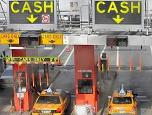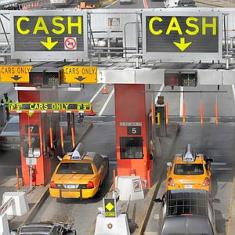 Cheating taxi riders out of big bucks is way too E-Z. Thousands of cabbies are ignoring their required E-ZPass tags, taking the snail’s-pace cash lanes at the city’s toll crossings — a ploy that jacks up riders’ fares by an estimated $750,000 a year.Meanwhile, taxi officials have dropped the ball on enforcing the E-ZPass requirement — costing the city millions more in lost fines.
Cheating taxi riders out of big bucks is way too E-Z. Thousands of cabbies are ignoring their required E-ZPass tags, taking the snail’s-pace cash lanes at the city’s toll crossings — a ploy that jacks up riders’ fares by an estimated $750,000 a year.Meanwhile, taxi officials have dropped the ball on enforcing the E-ZPass requirement — costing the city millions more in lost fines.
For 10 consecutive workdays, The NY Post observed an average of 56 cabs taking the cash lanes at the Queens-Midtown Tunnel between 9 a.m. and 10 a.m.
“This goes on all the time,” one veteran tunnel officer said. “[At] the cash lanes, especially during rush hour, there could be a seven-minute wait. That meter is ticking.”
For duped riders, the result is a higher fare — a consequence some cabbies openly admitted.
 “How can we make money if we [don’t]?” said Satish Kumar, after being confronted by an undercover reporter. “I’m a new driver anyway, and I don’t have E-ZPass, yet.”
“How can we make money if we [don’t]?” said Satish Kumar, after being confronted by an undercover reporter. “I’m a new driver anyway, and I don’t have E-ZPass, yet.”
The Post took 12 undercover rides through the tunnel, and two of the drivers used the cash lanes.
One of the hacks, Registre Francois, insisted that his E-ZPass was “not working.”
“I don’t want to go through the trouble of getting it to work,” he said.
At the MTA’s five major bridges and tunnels, the cash toll is $5.50, but the E-ZPass discount drops the price to $4.57.
Either way, the customer pays the toll, which is figured into the final fare and ultimately increases the tip amount.
And then there’s the indirect cost to riders — the one that cabbies profit from.
Waiting at the longer cash lanes during slow-moving traffic could cost a rider an additional 40 cents for each minute the cab isn’t moving over 12 mph.
Factoring in a seven-minute wait at a rush-hour toll plaza and a 20-percent tip, a trip from Chelsea to Greenpoint using the Queens-Midtown Tunnel would cost a rider an extra $3.40.
Using that figure, The Post calculated the total annual extra cost to riders whose cabs would take the most popular tolled crossings: the Queens-Midtown and Brooklyn-Battery tunnels and the former Triborough Bridge (now called the Robert F. Kennedy Bridge).
It comes to $750,000 a year in overcharges — and that’s just at those three crossings at rush hour during the five-day work week.
Lax enforcement compounds the problem, hurting the city’s pocketbook because potential fines aren’t being collected.
If the Taxi and Limousine Commission hit only the 56 daily offenders spotted by The Post with a $50 fine, the city would rake in an additional $1,040,250 a year in revenue.
Taxi officials said they need to choose between enforcing the E-ZPass rule and others, such as the ban on cellphone use and regulations against refusing fares.
“While our rotation of enforcement priorities does not allow us to be at the bridge and tunnel plazas every day, we get to them as often as we can, and our targeted operations are effective,” said TLC spokesman Allan Fromberg.
Hacks have a host of excuses for not using E-ZPasses.
“The biggest one is ‘I got stuck in the cash lane,’ ” said Lt. Mike Friscia, a veteran TLC enforcement officer. “But that’s rarely the case.”
At a recent TLC cash-lane enforcement sting on the RFK Bridge, a team of officers nailed 50 drivers from 6 a.m. to 9 a.m.
“Sounds like a rip-off,” said one of the scofflaw cabbies’ passengers, Adam Mincham. “I just came off a long flight and was looking to get home.”
The driver, Rafel Polanco, was sent a summons in the mail. He claimed his E-ZPass transponder was broken.
Another scammed rider, a California tourist, figured out the ruse when her driver was pulled over.
“It helps them charge a bigger tip!” she said.
{NY Post/Noam Amdurski-Matzav.com Newscenter}












Chutzpah.